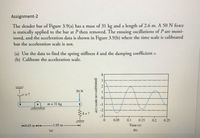
Elements Of Electromagnetics
7th Edition
ISBN: 9780190698614
Author: Sadiku, Matthew N. O.
Publisher: Oxford University Press
expand_more
expand_more
format_list_bulleted
Concept explainers
Question
The slender bar of Figure 3.9(a) has a mass of 31 kg and a length of 2.6 m. A 50 N force is statically applied to the bar at P then removed. The ensuing oscillations of Pare moni- tored, and the acceleration data is shown in Figure 3.9(b) where the time scale is calibrated but the acceleration scale is not. (a) Use the data to find the spring stiffness k and the damping cocfficient c. (b) Calibrate the acceleration scale.

Transcribed Image Text:Assignment-2
The slender bar of Figure 3.9(a) has a mass of 31 kg and a length of 2.6 m. A 50 N force
is statically applicd to the bar at P then removed. The cnsuing oscillations of P are moni-
tored, and the acceleration data is shown in Figure 3.9(b) where the time scale is calibrated
but the acceleration scale is not.
(a) Use the data to find the spring stiffncss & and the damping cocfficient c.
(b) Calibrate the acceleration scale.
50 N
C=?
m = 31 kg
k= ?
0.05
0.1
0.15
0.2
0.25
0.65 m-
1.95 m
Time (s)
(a)
(b)
at) (scale not calibrated)
Expert Solution
This question has been solved!
Explore an expertly crafted, step-by-step solution for a thorough understanding of key concepts.
This is a popular solution
Trending nowThis is a popular solution!
Step by stepSolved in 3 steps

Knowledge Booster
Learn more about
Need a deep-dive on the concept behind this application? Look no further. Learn more about this topic, mechanical-engineering and related others by exploring similar questions and additional content below.Similar questions
- Consider the dynamic system shown below. Rod Pulley Rc Rod Pulley RA = 10 cm PIB 1A The following parameters are given for the system: m₂ = 1 kg RA mg mc 2 kg RB Rc 20 cm m₂ = 3 kg R₂ = 30 cm k = 1200 N/m Note that pulleys A and B are constrained to move together and pulleys C and D are constrained to move together. Useful note... a. Obtain the characteristic equation(s) for this system. b. The applied force is removed. Then, pulley A/B is turned 2 degrees and released from rest. Find the system response.arrow_forwardAnswer it correctly please. State proper reason. I will rate accordingly.arrow_forwardGiven an oscillator of mass 2.0kg and spring constant of 180N/m, what is the period without damping? Use numerical methods to model this oscillator with an additional friction force equal to where c is a positive damping constant. Using c=5.0, what is the new period of oscillation. What about for c=10? Assume initial position is 0.2m and initial velocity is zero. Please find the period using the position versus time plot and use the first full cycle of the motion.arrow_forward
- Fast pls solve this question correctly in 5 min pls I will give u like for sure Sini.arrow_forwardConsider the following hydraulic / mechanical system, where pi and P2 are the inputs to the system, and the piston is driving a pendulum. Assuming small angles 0 and a concentrated mass ma distance L1 from the pivot. Pell (P2 R2 P1 Pa ¡P3 R1 P4 L2 Li Develop the dynamic equation to model of the piston displacement, 0, as a function of the inputs, p1 and p2 in standard form. b. If you were to consider the input to the system to be the difference between the pressure on 0(s) either side of the piston, write the transfer function for the displacement of the piston: AP(s) Xj = 0 c. Develop the state equations for this system if the state variables are:arrow_forward
arrow_back_ios
arrow_forward_ios
Recommended textbooks for you
 Elements Of ElectromagneticsMechanical EngineeringISBN:9780190698614Author:Sadiku, Matthew N. O.Publisher:Oxford University Press
Elements Of ElectromagneticsMechanical EngineeringISBN:9780190698614Author:Sadiku, Matthew N. O.Publisher:Oxford University Press Mechanics of Materials (10th Edition)Mechanical EngineeringISBN:9780134319650Author:Russell C. HibbelerPublisher:PEARSON
Mechanics of Materials (10th Edition)Mechanical EngineeringISBN:9780134319650Author:Russell C. HibbelerPublisher:PEARSON Thermodynamics: An Engineering ApproachMechanical EngineeringISBN:9781259822674Author:Yunus A. Cengel Dr., Michael A. BolesPublisher:McGraw-Hill Education
Thermodynamics: An Engineering ApproachMechanical EngineeringISBN:9781259822674Author:Yunus A. Cengel Dr., Michael A. BolesPublisher:McGraw-Hill Education Control Systems EngineeringMechanical EngineeringISBN:9781118170519Author:Norman S. NisePublisher:WILEY
Control Systems EngineeringMechanical EngineeringISBN:9781118170519Author:Norman S. NisePublisher:WILEY Mechanics of Materials (MindTap Course List)Mechanical EngineeringISBN:9781337093347Author:Barry J. Goodno, James M. GerePublisher:Cengage Learning
Mechanics of Materials (MindTap Course List)Mechanical EngineeringISBN:9781337093347Author:Barry J. Goodno, James M. GerePublisher:Cengage Learning Engineering Mechanics: StaticsMechanical EngineeringISBN:9781118807330Author:James L. Meriam, L. G. Kraige, J. N. BoltonPublisher:WILEY
Engineering Mechanics: StaticsMechanical EngineeringISBN:9781118807330Author:James L. Meriam, L. G. Kraige, J. N. BoltonPublisher:WILEY

Elements Of Electromagnetics
Mechanical Engineering
ISBN:9780190698614
Author:Sadiku, Matthew N. O.
Publisher:Oxford University Press

Mechanics of Materials (10th Edition)
Mechanical Engineering
ISBN:9780134319650
Author:Russell C. Hibbeler
Publisher:PEARSON

Thermodynamics: An Engineering Approach
Mechanical Engineering
ISBN:9781259822674
Author:Yunus A. Cengel Dr., Michael A. Boles
Publisher:McGraw-Hill Education

Control Systems Engineering
Mechanical Engineering
ISBN:9781118170519
Author:Norman S. Nise
Publisher:WILEY

Mechanics of Materials (MindTap Course List)
Mechanical Engineering
ISBN:9781337093347
Author:Barry J. Goodno, James M. Gere
Publisher:Cengage Learning

Engineering Mechanics: Statics
Mechanical Engineering
ISBN:9781118807330
Author:James L. Meriam, L. G. Kraige, J. N. Bolton
Publisher:WILEY